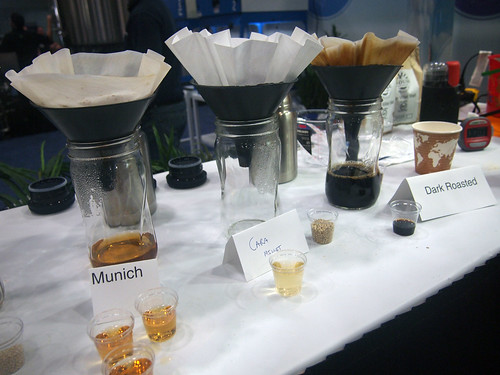The Craft Maltsters Guild was there at the recent Craft Brewers Conference in Washington, D.C., demonstrating the new Hot Steep Malt Sensory Method of the American Society of Brewing Chemists (ASBC).
At the Guild's booth, Jessica Johnstone of Grouse Malting (of Colorado) was kind enough to explain the process to me.
This is a demo of the ASBC Hot Steep Malt Sensory Method. It was published about a year ago. A lot of our malthouses have found it very beneficial for a multitude of purposes including brand development or quality control. Essentially, it's a hot steeped malt tea, filtered. Maltsters use it to identify aromas, tastes, flavors, and mouthfeel. Brewers can as well. We're looking for each batch of malt to taste the same, so we can market it as the same product. If there's an outlier, it's something we have to address.
A valuable test —developed by scientists Cassie Liscomb of Briess Malt & Ingredients and Lindsay Barr of New Belgium Brewing, it's a surprisingly uncomplicated procedure, using a coffee grinder and Thermos bottle, filter paper and jars. No expensive equipment needed, 'craft' brewers and maltsters.
"May I taste the samples," I asked Johnstone. "They're grainy and malty," she forewarned me.
"I've known only one brewer only who didn't like the taste of wort," I replied. "These samples are delicious."
-----more-----
- A description of the process by Cassie Liscomb: here.
- A slide presentation from co-developer Lindsay Barr, at the CBC: here.
- From the ASBC:
The brewing industry is in need of a rapid method for wort preparation to evaluate the extractable flavors and aromas that are present in malt. Historically, the standardized evaluation of malt has been limited to the measurement of physical and analytical properties and has notably not included sensory. Previous publications in brewing literature have documented malt sensory methods, but such methods have not been validated in order to gain acceptance as standard methods for the industry. Here we discuss findings from the hot-steep validation study, where repeatability and sensitivity were measured by a series of triangle tests. The design of the validation study dictates that the hot-steep method proves to be repeatable if identical wort samples prepared by two different technicians in the same laboratory are not found to be significantly different. Similarly, the method proves to be sensitive if two different malts prepared by the same technician in the same laboratory are found to be significantly different. Due to the perishable nature of wort, the study does not aim to prove reproducibility among different laboratories. A successful validation of the hot-steep method will lead to publication in the American Society of Brewing Chemists Methods of Analysis, which will make it the first method to be published in the area of raw materials sensory. [It has been.] This is a significant event for the brewing industry and will undoubtedly lead to the advancement of malt flavor research.
- More about the Craft Brewers Conference: here. More photos: here.
- What is the Craft Maltsters Guild? That question answered: here.
- Pic(k) of the Week: one in a weekly series of photos taken (or noted) by me, posted on Saturdays, and often, but not always, with a good fermentable as the subject.
- Camera: Olympus Pen E-PL1.
- Commercial reproduction requires explicit permission, as per Creative Commons.
- For more from YFGF:
- Follow on Twitter: @Cizauskas.
- Like on Facebook: YoursForGoodFermentables.
- Follow on Flickr: Cizauskas.
- Follow on Instagram: @tcizauskas.










No comments:
Post a Comment
Comment here ...